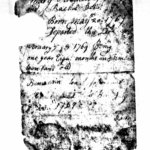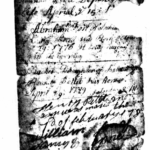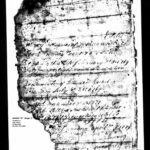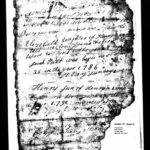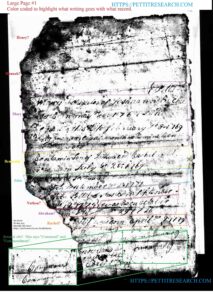Examining the Henry Pettit Sr. Family Bible Record and the Record of his Father Joshua Pettit (as preserved in the National Archives)
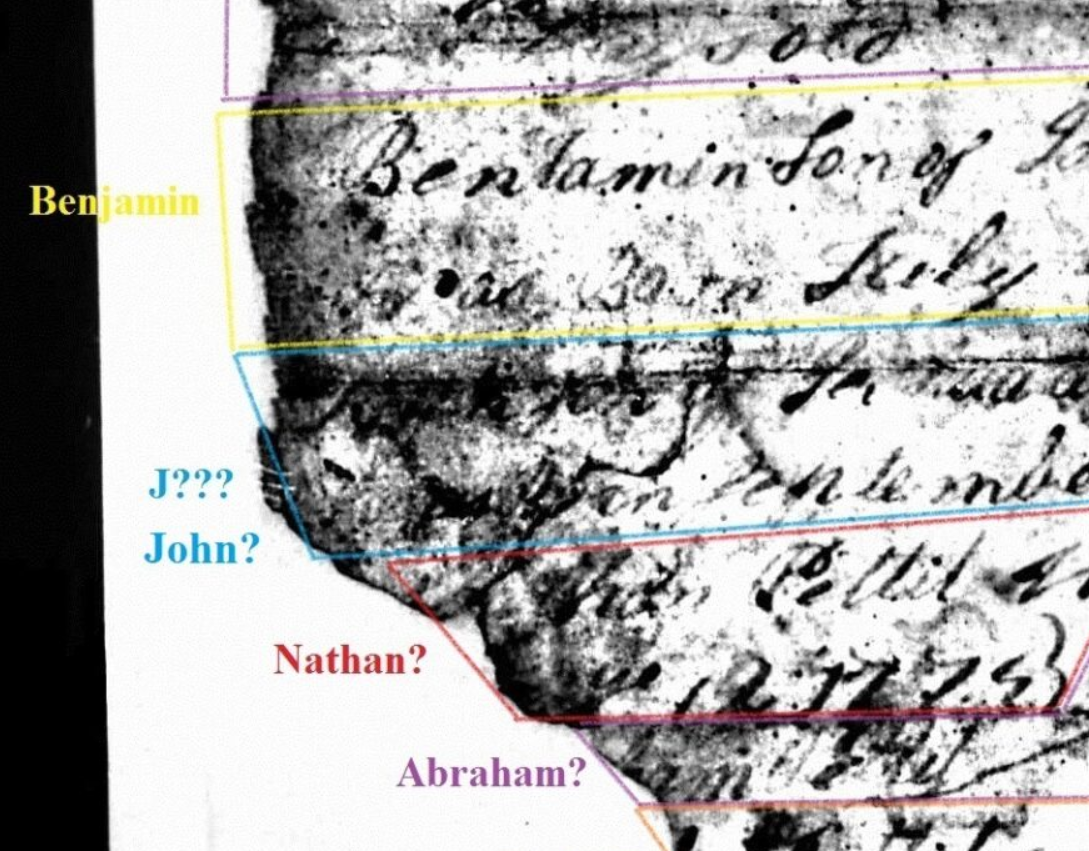
UPDATE TO THIS ARTICLE: An agreement was made with the National Archives to remove the Pettit Bible record from the vault in Washington DC for examination by The Pettit Research Project. The actual Bible record pages were scrutinized in person and, for the first time, full color images were made. Another article with full color pictures of these family records can be found by clicking here.
Examining the Henry Pettit Sr. Family Bible Record and the Record of his Father Joshua Pettit
(as preserved in the National Archives)
Brandon W. Pettit
On the 13th day of June in 1846 in Gilmer County, Georgia, John Pettit stood before his brother Henry Pettit Jr. (b. 1790), the Justice of the Inferior Court. His deposition that day was in regards to the settlement of the Revolutionary War pension account of his father Henry Sr. (b. 1763). John’s mother, Anna (Poole) Pettit, who had been in his care since the death of his father, had recently passed on as well. The court needed proof positive of John’s heirship. In an era well before the advent of state vital records John submitted the only written proof his family had. The court minutes detail two records that were submitted and were retained by the court. Over the course of time the records of most of these and other Revolutionary War pensions applications have been photocopied, microfilmed, and digitized before finally finding a permanent home. Today, the pages known as “The Pettit Family Bible” sleep quietly in a climate controlled vault in the National Archives in Washington, DC, protected from prying eyes and oily hands. We are fortunate they have survived for centuries and that we are still provided with copies to examine.
The two records submitted by John in 1846 are declared by him to be 1) a leaf of a small book and 2) a leaf from his father’s family Bible. Here is how he describes the first:
“…he herewith forwards to accompany his declaration an old leaf of a small book with a partial record of his grandfather’s family births in the handwriting of his grandfather and the marriage of his father and mother in the handwriting of his father the said Henry Pettit…”[1]
The second record is described as follows:
“…that by a record in the handwriting of his father the said Henry also in his possession in his family Bible he finds his father was born January 22, 1763 and his mother the said Ann was born February 1763 that she was never afterwards married (after the death of his father as aforesaid) that he also forwards a leaf found in his father’s family Bible in his possession in the hand writing of his father the births of his children and his mothers the said Ann…”[2]
(Note: These papers are attached to this document. As we examine these old pages from this point forward, it may be helpful to lay them beside this paper so they can be reviewed as comments are made.)
Enumerating the details given by John for these two records makes it easier to distinguish between them which we will need to do hereafter. For the sake of simplicity, let’s call the first record “Exhibit ‘J’” (for Joshua) and the second one “Exhibit ‘H’ (for Henry).”
Exhibit J (Joshua’s):
- It is described as “small” and, by implication, the smaller of the two documents.
- It is a partial record of the birth of John’s grandfather Joshua Pettit Sr.’s (1734?-1786?) children.
- It is in Joshua’s handwriting.
- It also records the marriage of Henry and Anna Pettit but this part of the record is in the handwriting of Henry.
Exhibit H (Henry Sr.’s):
- It is from Henry Pettit Sr.’s (1763-1838) family Bible.
- It is in the handwriting of Henry.
- It lists the children of Henry and Anna Pettit.
- It is supposed to contain the specific birth date of Henry Pettit Sr., which is apparently absent from the other document.
Looking at the two Exhibits this is precisely what we find. Exhibit “J” and Exhibit “H” as included with this paper are actually 4 individual pages taken from the National Archives m804 microfilm. However, it is obvious by examining the rips, tears, and holes that these are just front and back copies of only two original pages. Exhibit “J” is the small leaf that records a partial record of the births of Joshua Pettit’s (1734?-1786?) children in his own handwriting. Exhibit “H” is the page from Henry Pettit Sr.’s (1763-1838) family Bible. The handwriting is distinctly different between the two except that at the end of the last page of Exhibit “J” the handwriting matches that of Exhibit “H.” This is where Henry Sr. recorded his marriage to Anna Poole exactly as described to the court by John.
This cumbersome examination has a purpose. These details must be kept in the forefront because some important questions arise from these two records and the penmen of each must be considered. The large page (Exhibit “H”) for example, contains a copy made by Henry of the information in the original record made by Joshua (Exhibit “J”). The smaller record therefore is closer to the source for the record of Joshua’s children.
Exhibit “J”, the record written by Joshua Pettit, begins with his daughter Mary. It says:
“Mary daughter of Joshua and Rachel Pettit [was] born May ye 20 : 1767 [and] departed this life February ye 8 : 1769 being one year eight months and nine days old.”
John swore to the court that the record he was submitting was only a “partial” record of the children of his grandfather Joshua. The record starts with Mary in 1767. It also mentions Benjamin, Abraham and a daughter named Rachel. After the birth of Benjamin there is room to squeeze two or three names into the blurry area at the bottom of the page but not enough room for all the siblings that are thought to have lived. The complete list of children is thought to include Henry, Hannah, Mary, Benjamin, John, Nathan, Joshua Jr., Abraham, and Rachel. The small leaf is indeed a “partial record”. Probably absent from the record are those children born before Mary in 1767 which would include Henry Pettit who was born on January 22, 1763, and Hannah. This begs the question though. Why were they missing? Why did Joshua start the record with Mary? We will look at that later but first we’ll need to examine the birth order of the known children.
Sorting Out the Children of Joshua Pettit
The list of children in these records submitted by John, though somewhat obliterated, provides some useful facts.
The two tattered family records complement each other. Where one has missing data, the other can fill in the gaps. Even so there is much that is simply not legible. Taking into account a few sources outside of these records a list of the children of Joshua Pettit can be constructed. The following chart combines the data of the two records along with well-known external sources and includes a good dose of conjecture. This is the theorized birth order:
What follows is a summary of how this proposed order was determined.
Only Mary, Benjamin, Abraham, and Rachel all have clearly identifiable dates of birth on the two records. They are listed in BLUE
above to denote that they are considered established facts. Henry’s birthday is recorded in several other sources and it is also considered established. Henry was likely the oldest son in Spartanburg Co., SC, because he handled the family affairs after the supposed demise of his parents and in his father’s absence during the American Revolution.
On Exhibit “H”, which is the record of Joshua’s children copied by Henry, after the birth of Benjamin things get a little confusing. Another attachment has been included with this paper which attempts to segment out the zigzagging names and dates. (See supplementary attachment for Exhibit “H” page 1 colorized below.)
Looking at this attachment it appears there are two slots for children whose names are unknown, but whose dates are clearly legible. What can be seen is as follows:
- There was another son born after Benjamin on September 2, 1771. His name starts with a “J” and there is little space for a long name.
- There was another child born on September 12, 1775. This child’s name ends in “-than”.
After eliminating from the list those children in BLUE whose birthdays are known we are left with Hannah, Nathan, Joshua Jr., and John.
Nathan Pettit was 76 years old when enumerated in the Hancock Co., IL, census on November 6, 1850[3]. If this is correct he could only have been born between November 6, 1774, and November 6, 1775. He must therefore be the child born Sep 12, 1775, whose name ends with “-than.”
John Pettit, another probable son of Joshua, is 60-70 years of age in the 1840 Cherokee Co., GA, census.[4] If this is correct he could only be born between 1770-1780. After assigning Nathan to 1775, there is only one unknown person on the lines of the family record between 1770 and 1780 and that is the son born on September 2, 1771 whose name begins with “J.” There doesn’t appear to be enough space for “Joshua” and the partial letters seem to fit with the name “John.” (see below) Therefore, John is probably the son born September 2, 1771, whose name begins with “J.”
Hembree family tradition places Hannah’s birth year at 1765[5],[6]. She is thought to have married Joel Hembree sometime before 1790. She has been placed after Henry on the list for now until there is evidence to the contrary.
In the 1790 Spartanburg Co., SC, census only two Pettit brothers are enumerated as heads of household, Henry and Joshua Jr.[7] It is not known where Joshua Jr. should be placed in the birth order. Since he was head of household in 1790 it is not possible for him to have been born after Rachel in 1779. Most likely he belongs between Benjamin and John or between John and Nathan. However, there is no room for him in this space on the original record penned by Henry. There may be room on the record penned by Joshua. Could it be possible he was born between Henry and Mary? His name was omitted from the above chart because there is insufficient data to assign him a birthday anywhere at this time. This not to say there isn’t ample information to prove his existence. There is.
Recent tradition (i.e. old family group sheets) says he was born Sept 22, 1773. However, this may be taken from misreading Nathan’s line in the Bible. The “5” does look like a “3”. This tradition is possibly an error.
The Spartanburg County census gives us further clues to Joshua Jr.’s age.
- 1790: (16+) born before 1774.[8]
- 1800: (26-45) born between 1774 and 1755.[9]
- 1810: (45+) born before 1765. (an error?)[10]
- 1820: (45+) born before 1775.[11]
If we assume all the census data is correct, Joshua Jr. must be born between 1765 and 1755 due to the 1810 census which may be in error. If the 1810 census is an error then his birthday was simply sometime before 1774. He would fit nicely into the year 1773 but there doesn’t appear to be a 1773 on the Bible record copied by Henry. There may be room however, on Joshua’s record after the entry for Benjamin.
The birth order and names of these children is important but hard to define with the information at hand. The fact that the record starts with Mary and is only a partial list is intriguing. Even more intriguing though, is the possibility that the children may not even have had the same mother.
Joshua and Hannah Pettit?
[Note: The following section contains some theories that have been called into question after an in-person examination of the family Bible records was conducted. Click here for more info. 6/16/2025]
Both the small leaf and the Bible record of Henry Pettit mention repeatedly the children of “Joshua and Rachel Pettit.” However, a deviation from this standard pattern is recorded once in Exhibit “J”. This anomaly, penned by Joshua Pettit himself, is found at the top of page 2 of this small leaf.
After the birth of Benjamin in 1769 and before the birth of Abraham in 1776, we read the following:
“[?] son of Joshua and Hannah Pettit departed this life April ye 15 : [?]”
Here we have one singular record of a Joshua Pettit married to a Hannah Pettit and one of their children who passed away. Various attempts to find some other way to transcribe this that doesn’t result in a huge game of genealogical twister have been tried but nothing seems to make sense. There is a little space after “Joshua” to squeeze in “Rachel” but not “Rachel Pettit” as would be expected according to the pattern. Even if “Rachel Pettit” would fit, the whole continuity of the statement would be hopelessly lost at that point. To say “…son of Joshua and Rachel Pettit Hannah Pettit departed this life…” does not work.
The year this occurred is important but that part of the page is torn away. Chronologically, this entry follows the birth of Benjamin on page 1 in 1769 (including the large blurry gap afterwards) and precedes the birth of Abraham on page 2 in 1776. Taking into account the record copied by Henry Pettit and the birth order theorized above, it is thought that Nathan Pettit was born on September 22, 1775, and Abraham born October 29, 1776. This leave only one possible date for the year this son of Joshua and Hannah Pettit died; April 15, 1776.
Could Joshua Pettit Jr. be the Joshua who is referred to here as being the husband of Hannah? His birth date is yet unproven but presumed to be after 1763. If he married, fathered a child, and the child died by 1776 and if Joshua Jr. was about 16 years old at the time (young, but not unreasonable), then he would have to have been born in 1760 for this to work. This seems unlikely. He is known to have married Judith Poole, daughter of William Poole[12]. Judith Poole was likely born in Virginia in 1766[13]. Their first child was born in 1790. Joshua Jr. could have had a prior wife named Hannah but this would not seem to mesh well with the other known facts.
Other details omitted from the record loudly cry out to us. The bottom of page 1 is illegible, however there doesn’t seem to be enough room for all the “missing” children thought to belong to Joshua Sr. to fit in the blurry area. Since the record starts with Mary in 1767 and lists her as the “daughter of Joshua and Rachel Pettit” it is worth considering the possibility that the children born before this date are not recorded. Is it possible they had a different mother, namely Hannah?
Examining this hypothesis, an inevitable scenario emerges. Joshua Pettit first married a woman named Hannah. They had a child or children together and she died. Joshua then remarried, before 1767, a woman named Rachel. Joshua then began recording the births of his and Rachel’s children starting with Mary. Sometime before the birth of Joshua and Rachel’s son Abraham in 1776, one of the sons of Joshua and Hannah died and he recorded this in the record as well. This would explain the anomaly. However, this is nothing less than a theory. There is no other evidence to support this notion and it is just one of many ways to explain the mysterious Hannah in this document.
The Handwriting of Joshua and Henry
The fact that we have identified the handwriting of Joshua is also of some value.
Several sources of Henry Pettit Sr.’s handwriting and signatures are known to exist. His writing is consistent and easily identifiable. It can be found in the same Revolutionary War pension application mentioned above. It can also be confirmed by comparing it to his handwriting from the minutes of First Broad Baptist Church[14] and his signature on his will from 1838[15]. Henry has a unique style letter “P”. It is this “P” which is seen clearly anytime the name “Pettit” appears on the pages of Exhibit “H” and on the marriage record on Exhibit “J”.
On the other hand, there is only one known South Carolina document that bears the actual signature of Joshua Pettit and that is the July 7, 1777, deed of John Nuckols to William Wofford in which Joshua was a witness.[16] There are two signatures from Joshua on this document. It is believed to be the original deed and not something that was re-recorded by a clerk. (The illegal Richard Pearis land deal[17] is another candidate but thought to be a reproduction by a clerk and does not contain original signatures of witnesses.) Joshua Pettit’s signature has a unique “P” that has two loops at the bottom. See below from the 1777 Wofford deed:
 Joshua Pettit’s “P.”
Joshua Pettit’s “P.”
Unlike Joshua’s “P”, Henry’s “P” has no loops at the bottom but has a distinct small loop at the upper right of the “P”. See below taken from the 1838 will:
 Henry Pettit’s “P.”
Henry Pettit’s “P.”
Pulling out the attached papers and looking at the two Exhibits one can compare the “P”’s from Exhibit “J” to those known to belong to Joshua and Exhibit “H” to Henry. You will find both father and son’s handwriting distinct, consistent, and easy to identify.
A consistent signature is an acceptable form of identification for drivers’ licenses and banks. As we trace Joshua’s footsteps from New Jersey to Virginia and then on to South Carolina we will hopefully produce more documents that bear his mark. One such document has been found in New Jersey.

Oddly enough, the signature of Joshua Pettit on the August 15, 1759, Oliver Cushman inventory in Elizabeth, New Jersey,[18] does not match any signatures in any of these Bible records or other documents at all. It is not yet known if the NJ document contains the original signatures or a clerk’s reproduction (Below image is from the Essex Co, NJ Oliver Cushman inventory.)
The hunt for the original warrant sheets from Hardy Co., VA, where it is thought Joshua acquired land in 1769 is also underway. These would include an assignment paper on the back and probably his signature. A handwriting analysis for any of these records would be very helpful. It would seem good genealogy, or maybe the absence thereof, sometimes overlaps the field of forensics.
Future Research
What can we glean from all this? Here are a few points in summary and some pleas to other researchers for help:
- Since there is a Joshua Pettit signature confirmed by two independent documents (the family birth record and the Wofford deed) then every record that bears his signature needs to be located and examined. It is possible to identify him in Virginia and New Jersey using this method. Unfortunately, none of the Virginia records that have been located to date have his signature. A warrant is missing from the Joshua Pettit grant in Hampshire Co., VA, for land on Deep Spring Run. This needs to be located. Fellow researchers are invited to aid in the search for records of Joshua Pettit in old Hampshire/Hardy Co., VA. There is only one known signature from the record of a Joshua Pettit in New Jersey and it looks radically different than the one in South Carolina. A Joshua Pettit owned land in Essex Co., NJ, at some point in time but this actual deed has also not been uncovered yet. We need to find the original land warrant for Joshua Pettit in VA and the original deed for Joshua Pettit in Essex Co., NJ.
- The possibility needs to be considered that Joshua may have had a wife prior to Rachel named Hannah. If the transcription of this record is correct, they had at least one son, and possibly other children. If others existed, where they lived, where they died, and their possible offspring are all things that need to be looked into. Hannah’s maiden name, if discovered, may provide clues to establish Rachel’s.
- Joshua Pettit Jr. who married Judith Poole needs to be reexamined. Numerous errors exist online regarding him and his progeny. (For example, one common tree shared among researchers confuses a Nathaniel H. Pettit with Joshua Jr.’s son Nathan. Nathan moved with his siblings to Alabama while Nathaniel H. remained in Spartanburg Co., SC. Nathaniel H.’s father is unknown but may be John, the suspected son of Joshua Sr.)
- The information submitted to the Gilmer County, GA, court was only that information needed to prove the heirship of Henry Sr.’s children. It is unclear if there were other records that went along with the “partial” record of Joshua. An effort is being made to track down the rest of the Pettit Bible and other family records that may have existed. Any information regarding the Pettit Bible or Bibles will be welcomed.
- “Exhibit J” in this paper was not included on the original “Selected” m805 microfilm of the National Archives and thus this valuable record was hidden for many years. The copies provided are missing substantial portions which may contain critical information. It is possible the torn fragments are simply laying loose in the file folder in the Archives and have not been filmed or digitized. In 2018 a request was made to set up an in-person examination of Henry Pettit’s file but was denied by the National Archives.[19] The Archivist stated, “In the three years I’ve been here, maybe once has anything been pulled from the vault for anyone.” Once records have been digitized they are locked in the vault and not accessible except in very rare circumstances. This is understandable but a hindrance to research nonetheless.
Brandon W. Pettit
[Research by Brandon W. Pettit of Mounds, OK. Published on February 2, 2019. (Revised August 26, 2020), Revised again June 16, 2025]
Download PDF of Formal Paper: The Mystery of the Henry Pettit Family Bible Record and the Record of Joshua Pettit by BWPettit revised 8-26-2020
Leave a Comment!
We have an online forum for comments and questions. Follow this link to comment on this paper:
COMMENT HERE: The Mystery of the Henry Pettit Family Bible Record and the Record of Joshua Pettit
- Record for Henry Pettit, Anna or Ann Petit W5528; Pension and Bounty Land Warrant Application Files, 1800–1960; Department of Veterans Affairs, Record Group 15; National Archives, Washington, D.C.; (National Archives and Records Administration microfilm publication M804). ↑
- Ibid. ↑
- 1850 U.S. Census, Hancock Co., IL, population schedule, p. 722 (636B), enumeration district (ED) not stated, dwelling 1355, family 1357, Nathan Pettit; NARA microfilm publication M432, Roll 109, NARA, Washington D.C. ↑
- 1840 U.S. Census, Cherokee Co., GA, population schedule, p. 177, enumeration district (ED) 823, John Pettit; NARA microfilm publication M704, NARA, Washington D.C. ↑
- George Pettett, Pettett & Pettit: This Family Business, (Wolfe City, TX. :Lochaber Books, 2001) pp 22-25 ↑
- Eula Hembree Nichols letter to George Pettett, January 23, 1995, George Pettett Genealogy Collection, c/o B. W. Pettit, PO Box 505, Mounds, OK. ↑
- 1790 U.S. Census, Spartanburg District, SC, population schedule, p. 26, Joshua Pettit, Henry Pettit; NARA microfilm publication M637, Roll 11, NARA, Washington D.C. ↑
- Ibid ↑
- 1800 U.S. Census, Spartanburg District, SC, population schedule, p. 206, Joshua Pettit; NARA microfilm publication M32, Roll 50, NARA, Washington D.C. ↑
- 1810 U.S. Census, Spartanburg Co., SC, population schedule, p. 409, Joshua Pettit; NARA microfilm publication M252, Roll 71, NARA, Washington D.C. ↑
- 1820 U.S. Census, Spartanburg Co., SC, population schedule, p. 279, Joshua Pettit; NARA microfilm publication M33, Roll 120, NARA, Washington D.C. ↑
- “Pool, William”, deceased, Real Estate Cash Book 1830-1836, March 3, 1834; Spartanburgh District, South Carolina, pg. 17 (Columbia, SC: Historical Commission of South Carolina by the State company, 1935-) AA 5901, Roll 117, p427-428. ↑
- Judith’s sister Ann Poole born in 1764 and her brother William Abijah Poole born in 1766 were both born in Virginia according to various 1880 census records of their children ↑
- Copied by Viola H. Jones of Louisville, TN, from the actual minute book of First Broad Baptist Church. ↑
- Will of Henry Pettit Sr., August 3, 1838; Wills, 1663-1978; Estate Papers, 1802-1968 (Rutherford County); North Carolina. Division of Archives and History; Probate Place: Rutherford, North Carolina ↑
- John Nuckols to William Wofford deed witnessed by Joshua Pettit, July 7, 1777; Charleston Deeds, Vol B-5, p364-365, South Carolina Department of Archives and History ↑
- Principal Chiefs of the Cherokee to George Pearis, December 21, 1773; Public Register S363001, Conveyance Book E5, pp502-505, ST158 ↑
- Inventory of Oliver Cushman by Joshua Pettit, August 15, 1759; Elizabeth, Essex Co, NJ ↑
- Cheeseboro, Brian, Archives Technician, National Archives and Records Administration. “RE: Your Records Request.” Message to Brandon W. Pettit, August 10, 2018. Email ↑
